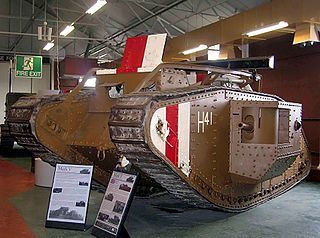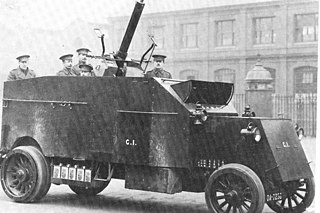
An armoured fighting vehicle or armored fighting vehicle (AFV) is an armed combat vehicle protected by armour, generally combining operational mobility with offensive and defensive capabilities. AFVs can be wheeled or tracked. Examples of AFVs are tanks, armoured cars, assault guns, self-propelled artilleries, infantry fighting vehicles (IFV), and armoured personnel carriers (APC).

A military armoredcar is a wheeled armoured fighting vehicle, historically employed for reconnaissance, internal security, armed escort, and other subordinate battlefield tasks. With the gradual decline of mounted cavalry, armored cars were developed for carrying out duties formerly assigned to light cavalry. Following the invention of the tank, the armoured car remained popular due to its faster speed, comparatively simple maintenance and low production cost. It also found favor with several colonial armies as a cheaper weapon for use in underdeveloped regions. During World War II, most armoured cars were engineered for reconnaissance and passive observation, while others were devoted to communications tasks. Some equipped with heavier armament could even substitute for tracked combat vehicles in favorable conditions—such as pursuit or flanking maneuvers during the North African campaign.

A tank is an armoured fighting vehicle intended as a primary offensive weapon in front-line ground combat. Tank designs are a balance of heavy firepower, strong armour, and battlefield mobility provided by tracks and a powerful engine; their main armament is often mounted within a turret. They are a mainstay of modern 20th and 21st century ground forces and a key part of combined arms combat.

The history of the tank includes all vehicles intended to advance under enemy fire while remaining protected.

The Canadian Automobile Machine Gun Brigade, also known as Brutinel's Brigade or the Brutinel Brigade, was the first fully motorized unit of the Canadian Expeditionary Force (CEF) during the First World War. It was established on August 24, 1914, in Ottawa, Ontario, Canada, as Automobile Machine Gun Brigade No. 1 by Canadian Brigadier-General Raymond Brutinel, who initiated the program and was the unit's first commander. The unit played a significant part in halting the major German spring offensive of March 1918, and in the final Hundred Days Offensive when it was part of the Canadian Independent Force (CIF) commanded by Brutinel.

The FV101 Scorpion is a British armoured reconnaissance vehicle and light tank. It was the lead vehicle and the fire support type in the Combat Vehicle Reconnaissance (Tracked), CVR(T), family of seven armoured vehicles. Manufactured by Alvis, it was introduced into service with the British Army in 1973 and was withdrawn in 1994. More than 3,000 were produced and used as a reconnaissance vehicle or a light tank.

The Rolls-Royce armoured car is a British armoured car developed in 1914 and used during the First World War, Irish Civil War, the inter-war period in Imperial Air Control in Transjordan, Palestine and Mesopotamia, and in the early stages of the Second World War in the Middle East and North Africa.

The Tank, Cruiser, Mk III, also known by its General Staff specification number A13 Mark I, was a British cruiser tank of the Second World War. It was the first British cruiser tank to use the Christie suspension system, which gave higher speeds and better cross-country performance; previous cruiser tank models had used triple wheeled bogie suspension.

The M8 light armored car is a 6×6 armored car produced by the Ford Motor Company during World War II. It was used from 1943 by United States and British forces in Europe and the Pacific until the end of the war. The vehicle was widely exported and as of 2024 still remained in service with some countries.

The M3 scout car was an American armored car produced in the World War II era, from 1939 to 1944. The original M3 scout car was produced in limited numbers, while the improved M3A1 scout car saw wide service during World War II and after.

The Simms Motor War Car was the first armoured car ever built, designed by F. R. Simms.

The Frot-Laffly armoured roller, also Frot-Turmel-Laffly armoured roller, was an early French experimental armoured fighting vehicle designed and built from December 1914 to March 1915.

The Charron, Girardot et Voigt 1902 was a French armoured car developed in 1902 by the company Charron, Girardot et Voigt. It was equipped with a Hotchkiss machine gun, and with 7 mm armour for the gunner. ·

The Büssing A5P was an armoured car produced in Germany during World War I.
Renault armoured cars were a number of armoured car variants produced in France during the First World War.

The Seabrook armoured lorry was a British heavy armoured car built on the chassis of an American 5-ton truck which saw service with the Royal Naval Air Service during the First World War.

The White AM armoured car was a French First World War armoured car that was built on a commercial American White Motor Company truck chassis with armoured bodies supplied by the French firm Ségur & Lorfeuvre, it was used by the French military from its introduction in 1915. Between the wars the French military completely rebuilt the vehicles as the White-Laffly AMD 50 and the Laffly-Vincennes AMD 80, in these guises it served until at least 1943.

The Pierce-Arrow armoured AA lorry was a self-propelled anti-aircraft carrier mounting a QF 2-pounder AA "pom-pom" gun, it was used by the Royal Marine Artillery during the First World War.

The Talbot armoured car was a British armoured car built on the chassis of a Clément-Talbot tourer. Built in small numbers to several patterns, the Talbot armoured cars saw service with the Royal Naval Air Service (R.N.A.S.) in the early years of the First World War, serving alongside Rolls-Royce and Delaunay-Belleville armoured cars.


























